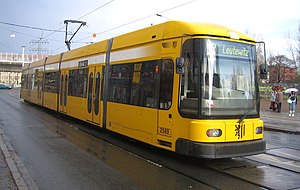Articulated railcar NGT6DD
| Articulated railcar NGT6DD | |
|---|---|
| Number: | 47 one-way trolleys 13 two-way trolleys |
| Manufacturer: | DWA Bautzen |
| Year of construction (s): | 1995-1998 |
| Length over coupling: | 30,280 mm |
| Width: | 2,300 mm |
| Empty mass: | 33.4 t / 34.5 t |
| Top speed: | 70 km / h |
| Hourly output : | 4 × 95 kW = 380 kW |
| Operating mode: |
One-way locomotive Two-way locomotive |
| Seats: | 88/72 |
| Standing room: | 96/112 |
NGT6DD represents N iederflur g élénk t railcars with 6 axes, type Dresden . Dresdner Verkehrsbetriebe owns a total of 60 railcars of this type. It was the first type of low-floor tram to be used in Dresden .
The vehicles were manufactured between 1995 and 1998 by Deutsche Waggonbau AG (DWA) - today: Bombardier - in Bautzen .
Structure and equipment
The NGT6DD is in the variants NGT6DD-ER for device operation (47 pieces) and NGT6DD-ZR for two-way operation been built (13 pieces). The ER wagons have the numbers 2501 to 2547, the ZR wagons the numbers 2581 to 2593. The main features of the bidirectional wagons are doors on both sides of the vehicle as well as being equipped with two fully-fledged driver's cabs , while the unidirectional vehicles only have an auxiliary driver's desk at the rear end for maneuvering. The rest of the technical equipment is essentially identical, and the seating in the bidirectional vehicle is mostly oriented towards the first driver's cab.
A railcar is 30.28 meters long and consists of five vehicle modules. Under the first and fifth module there is a two-axle power unit with an output of 2 × 95 kW. The third module houses a loose wheel drive. The two intermediate modules each have two (ZR variant: four) entry doors, which are implemented as electromechanically operated pivoting sliding doors.
A total of 184 people can be transported in an NGT6DD, whereby the ratio of seats / standing places varies depending on the equipment variant:
- NGT6DD-ER: Seats: 88, Standing: 96
- NGT6DD-ZR: Seats: 72, standing: 112
commitment
Basically, the use of the NGT6DD is limited to the comparatively less frequented Dresden tram lines (lines 1, 4, 6, 9, 10, 12 and 13). The bidirectional vehicles are preferred for construction work, as they make it possible to do without turning loops or track triangles (for example at temporary terminal stops).
Until the first NGT8DD was delivered , a. on line 2 also for use by NGT6DD in double traction.
Similar models
The eight-axle articulated multiple unit NGT8DD, which is two modules longer, was purchased from DVB as a successor model.

